Physical Address
304 North Cardinal St.
Dorchester Center, MA 02124
Physical Address
304 North Cardinal St.
Dorchester Center, MA 02124

Skip the overhyped tourist traps and discover 17 truly magnificent hiking routes that deliver breathtaking scenery without breaking your budget.
You’ve probably scrolled through countless hiking photos online, wondering which trails are actually worth your time and money. The truth is, not all “world-famous” routes live up to the hype—some are overcrowded tourist traps that’ll drain your wallet. But there are seventeen trails that consistently deliver jaw-dropping scenery, manageable logistics, and reasonable costs if you plan smart. Here’s what separates the truly magnificent hikes from the Instagram pretenders.
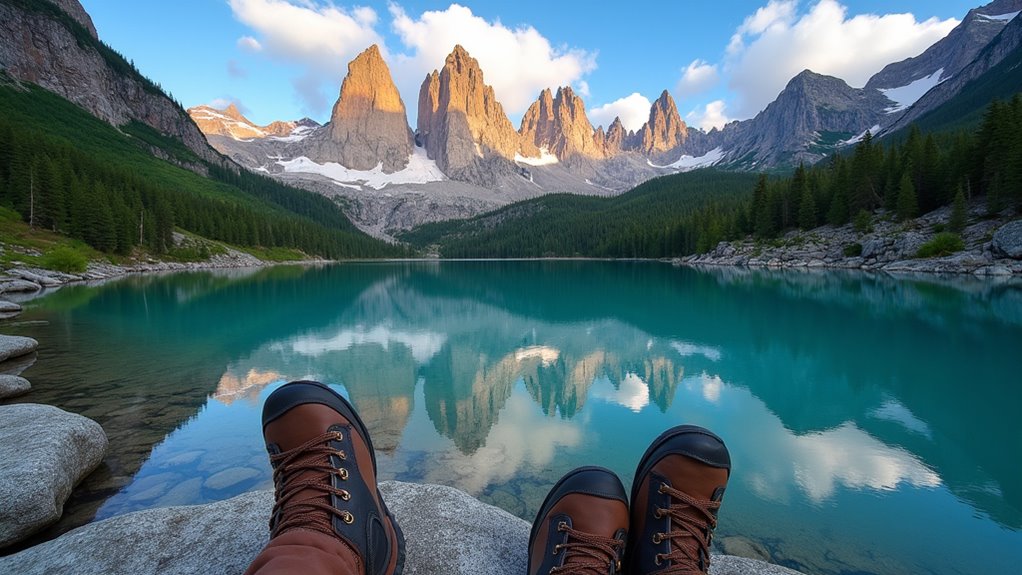
You’ll find one of South America’s most spectacular hiking adventures in Chile’s Torres del Paine National Park, where the famous W Circuit delivers jaw-dropping granite towers, emerald lakes, and ancient glaciers without breaking your budget.
This 4-5 day trek covers roughly 50 miles through Patagonia’s crown jewel, connecting iconic viewpoints like Base Torres and Grey Glacier.
Book refugios early or bring camping gear to save money. The shoulder seasons (October-November, March-April) offer fewer crowds and cheaper accommodations.
Pack layers since Patagonian weather changes rapidly. Don’t skip the French Valley – it’s the circuit’s most dramatic section.
Start from Las Torres base for the easiest logistics. Bus connections from El Calafate make this accessible even on tight budgets.
Consider bringing a lightweight hammock camping setup as an alternative to traditional tent camping, especially for warmer nights when you want to sleep under Patagonia’s incredible starry skies.
While most hikers flock to Japan’s crowded mountain trails, the ancient Kumano Kodo pilgrimage routes offer a profoundly different experience through mist-shrouded forests, traditional villages, and sacred shrines that’ve welcomed travelers for over 1,000 years.
Escape Japan’s tourist-packed trails for thousand-year-old pilgrimage paths winding through sacred forests and timeless villages.
You’ll discover six distinct routes spanning the Kii Peninsula, with the Nakahechi trail being most accessible for beginners. Don’t expect rugged terrain—these stone-paved paths wind gently through cedar groves and bamboo forests.
Budget around ¥8,000-12,000 daily for minshuku guesthouses and local meals.
Pack light rain gear since humidity stays high year-round. Spring offers cherry blossoms, while autumn brings stunning foliage. You can complete sections in day hikes or commit to the full 3-7 day journey.
Purchase a completion certificate at Kumano Hongu Taisha shrine—it’s your spiritual passport to this UNESCO World Heritage experience. This incredible trail consistently ranks among the world’s best hikes for its unique blend of spiritual significance and natural beauty.
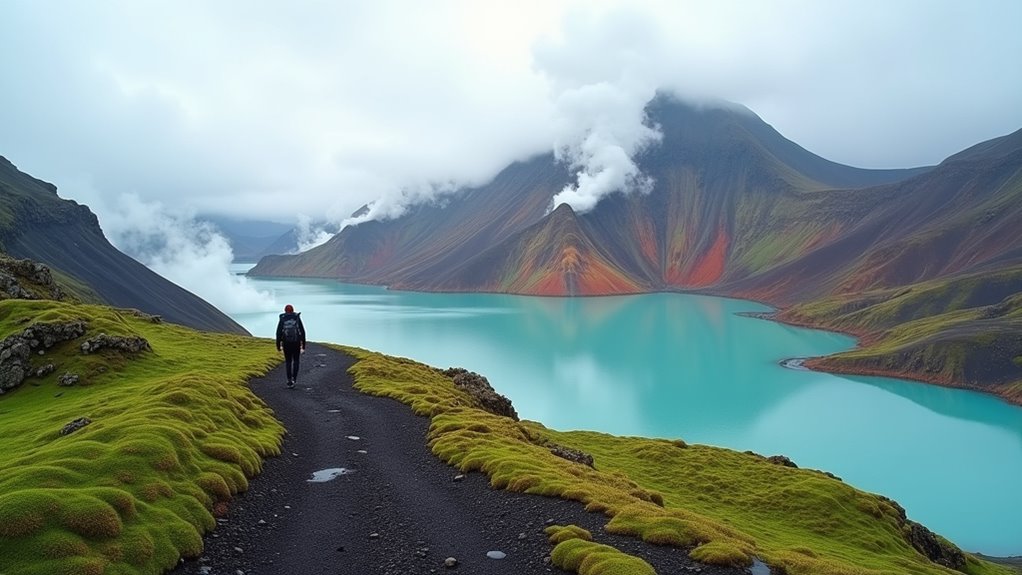
Iceland’s Laugavegur Trail cuts through some of Earth’s most alien landscapes, where rainbow-colored rhyolite mountains, steaming hot springs, and black volcanic deserts create scenery that’ll make you question which planet you’re on.
You’ll trek 34 miles from Landmannalaugar to Thorsmork over four days, staying in mountain huts that cost around $30-50 per night. Book early—they fill fast during summer season. Pack warm, waterproof gear since Iceland’s weather changes without warning.
The trail’s surprisingly accessible for beginners, with well-marked paths and river crossings via footbridges. You’ll pass turquoise lakes, massive glaciers, and geothermal areas perfect for natural hot tub soaks after long hiking days.
Budget roughly $200-300 total for accommodation, plus food costs if you’re not bringing your own supplies. For those seeking more technical glacier adventures, the US offers incredible glacier climbing opportunities on some of the continent’s most challenging ice formations.
Peru’s legendary Inca Trail delivers a perfect blend of ancient history and breathtaking Andean scenery as you follow stone pathways built centuries ago straight to the iconic ruins of Machu Picchu.
You’ll need advance permits since only 500 hikers can start daily—book months ahead through licensed operators. The classic four-day trek costs $600-800, covering 26 miles with challenging high-altitude sections reaching 13,780 feet.
Pack light but smart: quality hiking boots, warm layers, and rain gear are essential. Porters carry camping equipment, but you’ll haul your daypack.
Train beforehand—those steep stone steps and thin air will test your endurance. The reward? Watching sunrise illuminate Machu Picchu from the Sun Gate after days of stunning mountain vistas and fascinating archaeological sites.
Consider how your travel budget stretches differently across various destinations when planning your adventure of a lifetime.
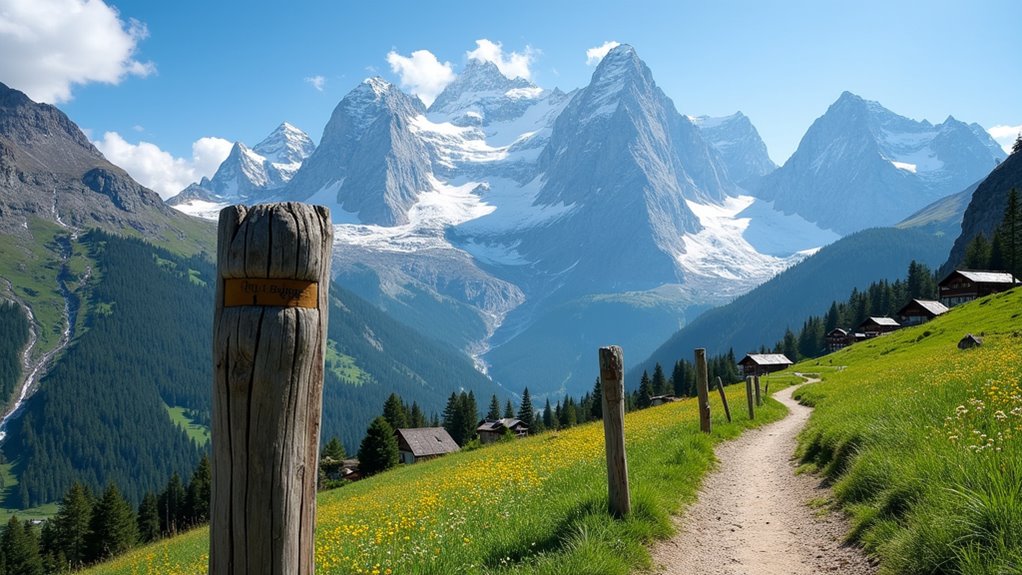
Circling Europe’s highest peak across three countries, the Tour du Mont Blanc ranks as one of the world’s most spectacular alpine adventures. It treats you to 110 miles of pristine mountain trails, charming villages, and jaw-dropping views of glaciers and 4,000-meter summits.
You’ll typically complete this circuit in 10-12 days, staying in mountain refuges that cost €35-60 per night including meals. Book accommodations months ahead during peak season (July-September). Pack layers since weather changes rapidly at altitude, and bring trekking poles for steep descents.
Start from Chamonix and hike clockwise for easier navigation. Don’t attempt this trek without proper fitness—you’ll gain 10,000 meters of elevation total.
Consider purchasing the TMB Passport for €2 to collect stamps from each refuge, creating a memorable souvenir of your alpine journey.
For those seeking equally breathtaking long-distance hiking experiences, Scotland’s West Highland Way offers another world-class trail renowned for its stunning highland scenery.
While many trails boast stunning scenery, New Zealand’s Milford Track delivers an unmatched wilderness experience through Fiordland National Park‘s ancient rainforests, thundering waterfalls, and dramatic fjords. You’ll need to book well ahead since only 40 independent walkers are permitted daily during the October-April season.
The 53-kilometer trail takes four days, with mandatory overnight stays at designated huts costing around $70 per night.
Pack waterproof gear – this region receives over 7 meters of annual rainfall. You’ll cross the challenging Mackinnon Pass at 1,154 meters, where weather changes rapidly.
Book the Milford Sound boat transfer in advance, as it’s your only exit option. Consider flying from Queenstown to Te Anau to save time and money on the drive.
If you’re planning to explore New Zealand by RV after your hike, research thoroughly to avoid common buying mistakes that could impact your road trip experience.
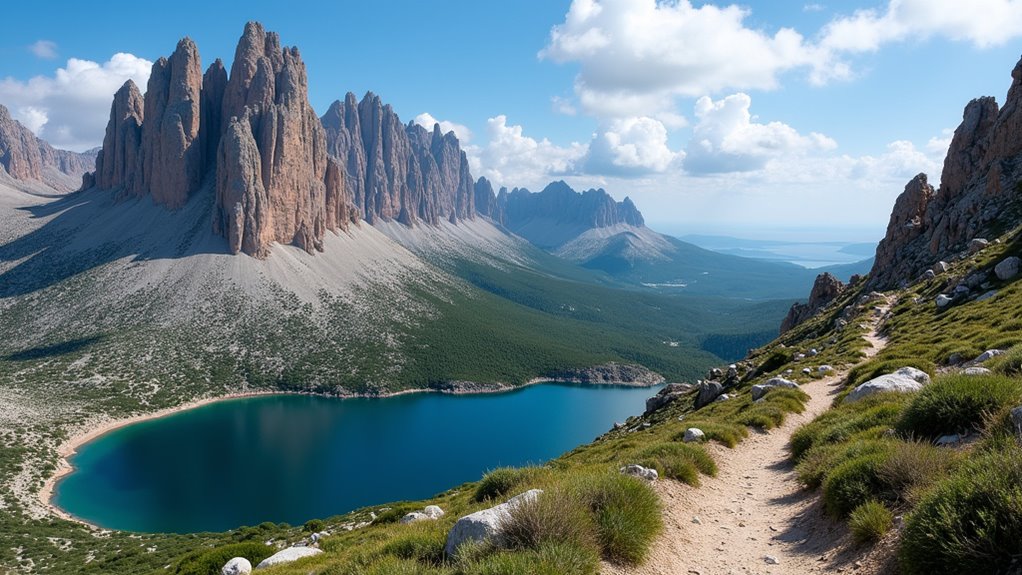
Why tackle Europe’s toughest long-distance hike when you could choose easier mountain trails? Because GR20’s 180-kilometer traverse across Corsica’s mountainous spine offers unmatched rewards for experienced hikers willing to endure the challenge.
You’ll scramble over granite ridges, navigate knife-edge arêtes, and witness jaw-dropping Mediterranean vistas. The trail’s notorious difficulty stems from technical rock sections, unpredictable weather, and minimal shelter options.
Budget wisely—you’ll spend €40-60 daily on mountain huts and meals. Pack lightweight gear since you’ll carry everything for 15 days. Stock up on supplies in Calenzana before starting, as resupply points are limited.
Don’t attempt GR20 without solid hiking experience and excellent fitness. The trail demands respect, but rewards those prepared with Europe’s most spectacular high-altitude wilderness experience. For those traveling with children, consider exploring family camping activities that offer adventure without the extreme technical challenges of high-altitude hiking.
From Europe’s granite peaks to the Himalayas’ towering giants, the Annapurna Circuit delivers Nepal’s most accessible high-altitude adventure without requiring technical climbing skills.
You’ll trek through rhododendron forests, terraced fields, and traditional villages before crossing the challenging Thorong La Pass at 17,769 feet.
Budget around $30-50 daily for teahouse accommodation and meals—you won’t need expensive camping gear.
The classic 15-21 day route starts in Besisahar, though road construction has shortened some sections.
October-November and March-May offer the clearest mountain views and stable weather.
Pack layers for dramatic temperature changes and bring altitude sickness medication.
Book teahouses ahead during peak season, but don’t worry—you’ll find warm dal bhat and stunning Himalayan panoramas waiting at every stop.
If you do bring camping equipment for certain sections, proper tent maintenance becomes essential in the harsh mountain conditions to ensure your shelter remains reliable throughout the trek.
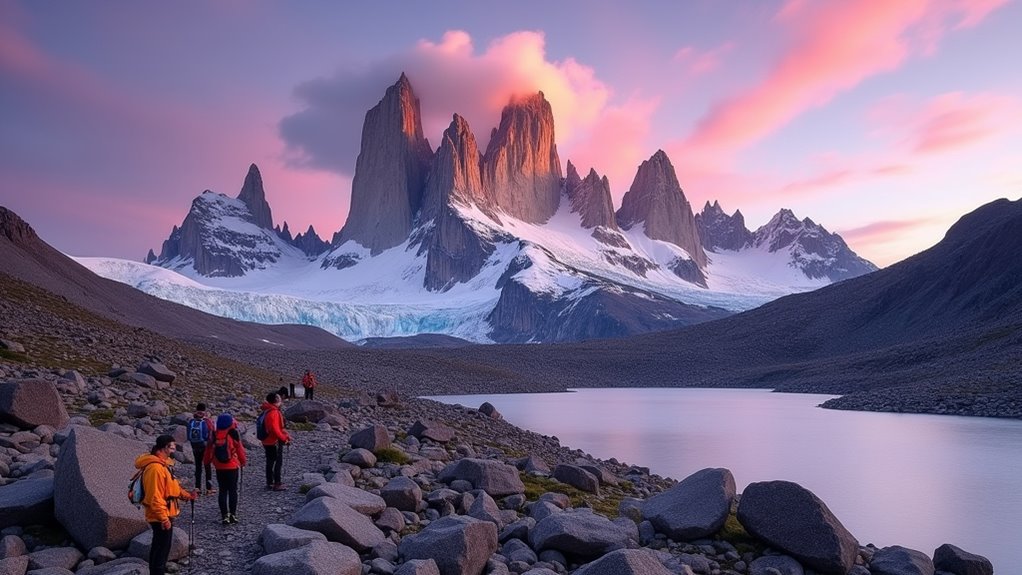
Three jagged granite spires pierce the Patagonian sky in Argentina’s Los Glaciares National Park, making the Fitz Roy Trek one of South America’s most dramatic day hikes. You’ll start from El Chaltén, Argentina’s trekking capital, where budget hostels cost around $15-20 nightly.
The 20-kilometer round trip takes 6-8 hours with steady uphill sections through lenga forests before opening into alpine terrain.
Pack layers—Patagonian weather changes rapidly. You’ll need sturdy boots for rocky sections and creek crossings. The final hour’s steep scramble rewards you with Laguna de los Tres and mind-blowing views of Fitz Roy’s 3,405-meter peak.
Don’t attempt this during winter (June-August) when trails become dangerous. Spring through fall offers your best shot at clear summit views.
While Patagonia’s dry climate means fewer insects than other hiking destinations, mosquito nets remain essential gear for trekkers visiting certain wetland areas during summer months.
Italy’s most spectacular alpine traverse winds 120 kilometers through the heart of the Dolomites, connecting mountain huts across UNESCO World Heritage peaks. You’ll trek from Lago di Braies to Belluno over 8-12 days, passing beneath towering limestone spires and crossing high mountain passes.
Book rifugios (mountain huts) months ahead—they’re your lifeline for meals and beds. Expect €25-40 per night for dormitory bunks, plus €15-25 for hearty dinners. Pack light since you’ll carry everything daily, but bring warm layers for unpredictable alpine weather.
The route’s well-marked with red-white blazes, though some sections require scrambling over rocky terrain. June through September offers the best conditions.
You’ll witness dramatic sunrise alpenglow on jagged peaks while experiencing authentic mountain hospitality that’s defined Alpine culture for centuries.
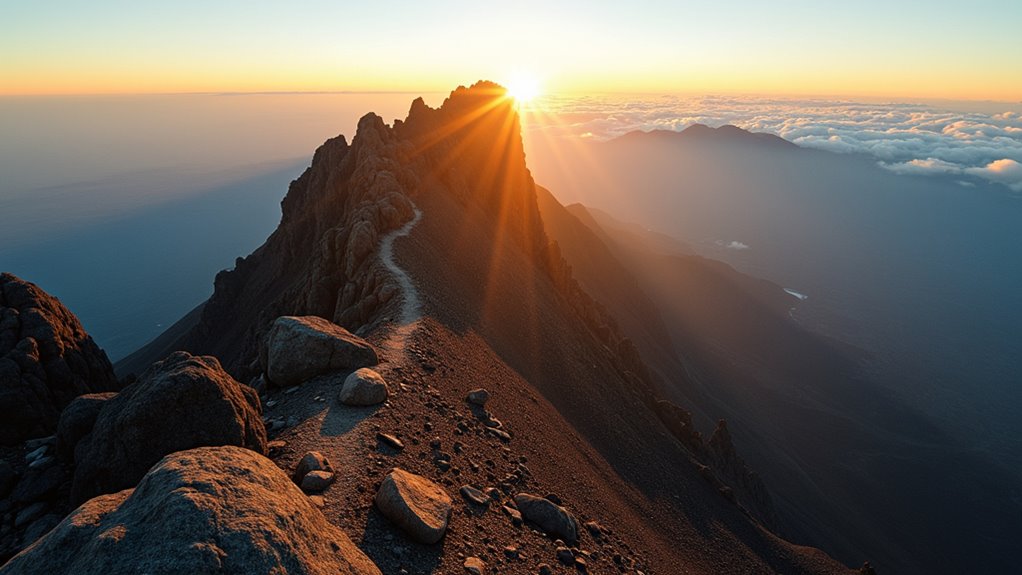
Eight days of gradual ascent through Kilimanjaro’s most remote and scenic route takes you around Africa’s highest peak via the lesser-traveled northern slopes. You’ll experience superior acclimatization compared to shorter routes, notably boosting your summit success chances.
The northern circuit offers stunning 360-degree views that most climbers never see, including dramatic landscapes toward Kenya.
Budget around $2,500-3,500 for permits, guides, and logistics – it’s pricier than popular routes but worth every penny. You’ll encounter fewer crowds, meaning pristine campsites and peaceful hiking.
Pack layers for extreme temperature variations from tropical base to arctic summit conditions.
Book during dry seasons: January-March or June-October.
Choose reputable local operators who prioritize safety and fair porter wages.
This route demands good fitness but rewards you with Kilimanjaro’s most spectacular and extensive experience. Consider bringing a self-contained camping trailer for your base camp setup if you’re planning extended stays in the region before or after your climb.
While millions have walked these ancient paths for over a thousand years, you’ll discover the Camino de Santiago offers something uniquely personal to every pilgrim. This network of routes across Spain culminates at Santiago de Compostela’s cathedral, where you’ll earn your Compostela certificate after completing at least 100 kilometers on foot.
Every step on these sacred paths reveals a deeply personal pilgrimage experience unique to your own spiritual journey.
Budget-friendly albergues (hostels) cost €5-15 nightly, and you’ll find affordable meals along the way. The most popular Camino Francés stretches 800 kilometers from France.
Here’s what makes this journey unforgettable:
When planning overnight stops, consider key factors for choosing the perfect campsite to ensure comfortable rest between walking segments.
You’ll return home transformed.
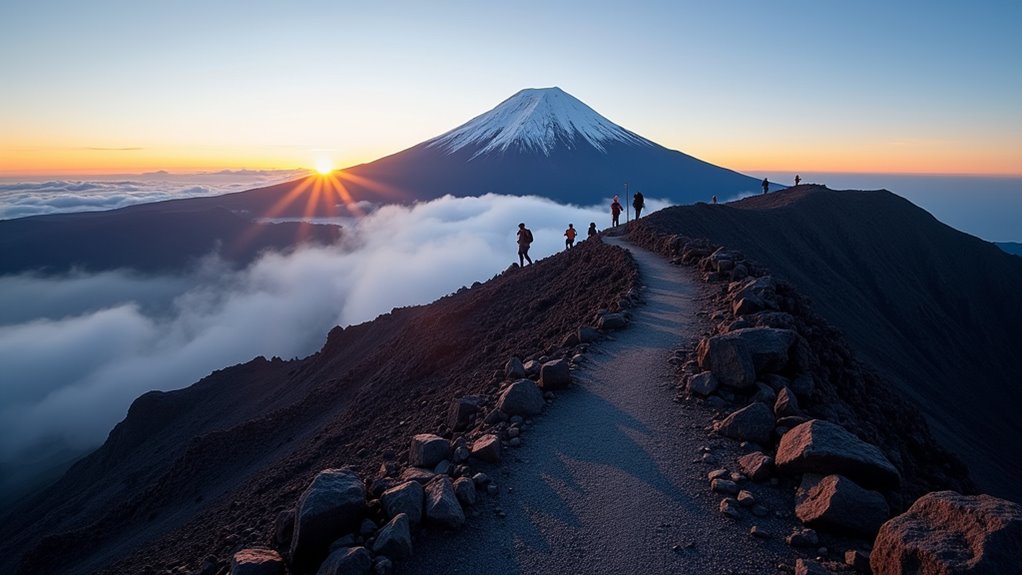
From Spain’s spiritual paths, Japan’s Mount Fuji presents an entirely different pilgrimage experience. You’ll tackle the Yoshida Trail, the most popular route up Japan’s sacred mountain, typically costing around $50-80 for the climb including huts and meals.
Start your ascent at Fuji Subaru Line 5th Station, accessible by bus from Tokyo. The trail’s well-marked with mountain huts every few hours where you can rest and refuel. Don’t underestimate the altitude—you’ll climb from 7,545 feet to 12,389 feet.
Time your hike for July-September when conditions allow climbing. Pack warm layers since temperatures drop markedly at night. Book mountain huts in advance during peak season.
You’ll witness an unforgettable sunrise from Japan’s highest peak, making every challenging step worthwhile. While Mount Fuji offers incredible hiking, Canada also boasts some of the world’s best fishing spots for those seeking different outdoor adventures.
Why settle for admiring Everest from afar when you can stand at its base camp? This legendary 12-day trek through Nepal’s Khumbu region delivers heart-pounding adventure without breaking the bank.
You’ll traverse suspension bridges, sleep in traditional teahouses, and witness jaw-dropping Himalayan vistas that’ll leave you speechless.
Budget around $1,200-$1,800 for permits, accommodation, and meals. Pack light but smart – altitude sickness is real above 8,000 feet.
Before embarking on this adventure, familiarize yourself with essential camping terms to better communicate with fellow trekkers and guides along the trail.
You’ll return forever changed by this bucket-list adventure.
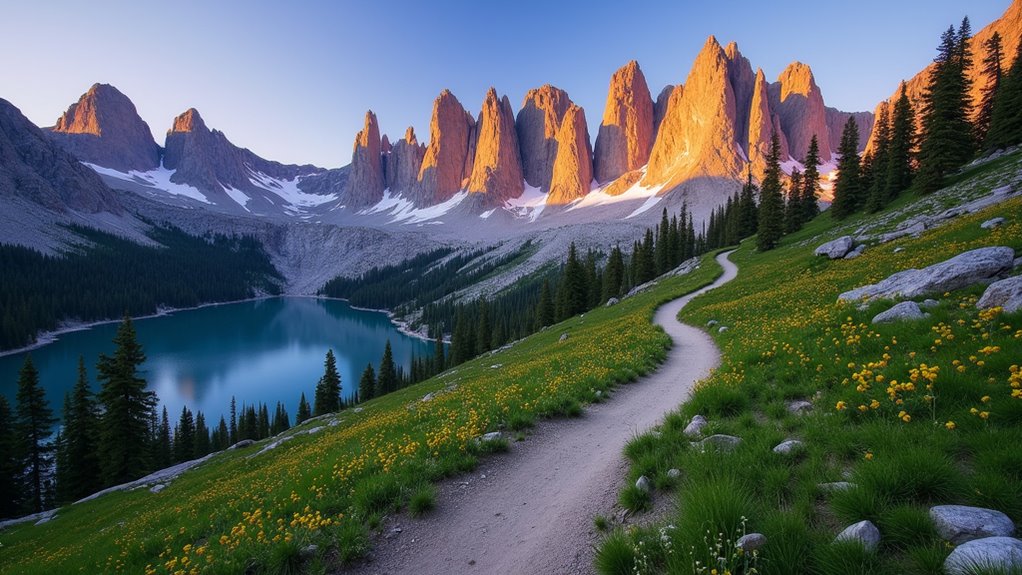
For 211 miles, you’ll follow John Muir’s footsteps through California’s most spectacular wilderness on what many consider America’s premier long-distance trail.
You’ll traverse the Sierra Nevada from Yosemite Valley to Mount Whitney, passing through three national parks and countless alpine lakes.
Budget around $800-1,200 for permits, food, and gear. Reserve permits well in advance—they’re competitive.
Most hikers take 2-3 weeks, resupplying at five locations along the route.
You’ll face 47,000 feet of elevation gain, so train extensively beforehand.
Pack lightweight gear since you’ll carry everything between resupply points.
Time your hike for July through September when snow’s minimal and creek crossings are safer.
The trail’s difficulty rewards you with pristine wilderness few experience.
Keep your camping essentials organized with a quality response pak to make resupplying and accessing gear more efficient at each stop.
Where else can you experience two UNESCO World Heritage areas on a single 20-mile trail? New Zealand’s Routeburn Track delivers this rare opportunity without breaking your budget. You’ll traverse Fiordland and Mount Aspiring National Parks over 2-4 days, witnessing dramatic landscape shifts that’ll leave you speechless.
Book huts early (they’re cheaper than camping gear rentals) and pack layers—weather changes fast here. The track’s well-maintained, making it perfect for intermediate hikers.
What you’ll experience:
Transport’s straightforward from Queenstown, and shuttle services keep costs reasonable. You’ll understand why locals call this track pure magic. If you’re considering other outdoor adventures, you might also weigh the pros and cons of renting versus buying equipment for activities like fishing excursions.
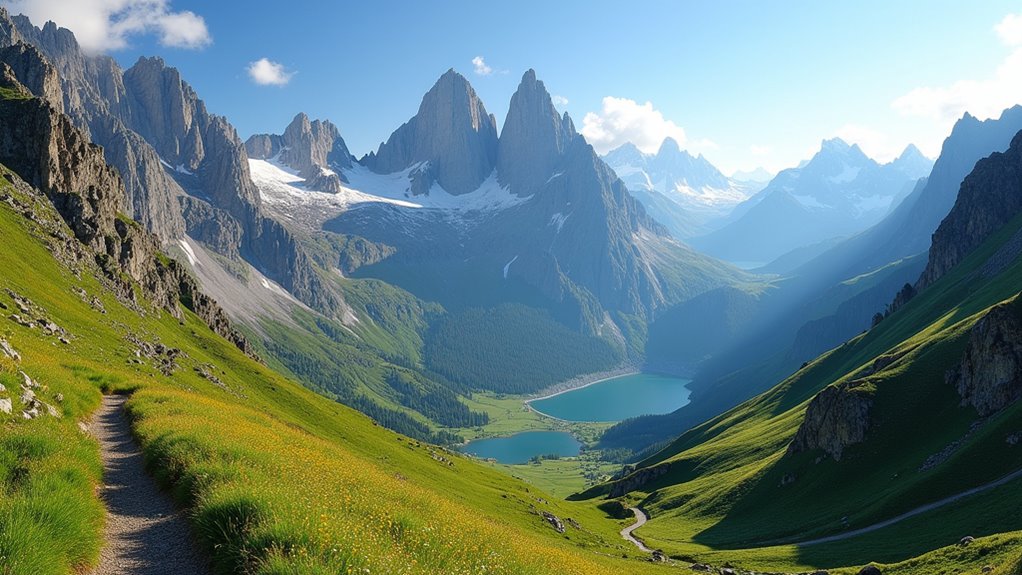
While New Zealand offers unmatched variety in a compact package, Europe’s crown jewel of alpine hiking spans two countries and delivers 180 kilometers of pure mountain euphoria. The Haute Route connects Chamonix, France to Zermatt, Switzerland through legendary peaks like Mont Blanc and the Matterhorn.
You’ll tackle challenging terrain with 12,000 meters of elevation gain over 10-12 days. Mountain huts provide affordable accommodation at €40-60 per night, including meals. Book early—they fill fast during July-September peak season.
Pack layers for unpredictable alpine weather and quality hiking boots for technical sections. The trail demands good fitness and basic mountaineering skills. Budget €100-150 daily including hut fees, meals, and lift tickets.
Weather can change rapidly, so flexibility’s essential for completing this iconic traverse. Master proper climbing footwork techniques to navigate the route’s steep rocky sections and technical scrambles safely.
Like seeds scattered across the earth’s canvas, these trails await your footsteps to bloom into memories. You don’t need a fortune to chase horizons—pack light, plan smart, and let your spirit be the compass. Each path’s a teacher disguised as adventure, offering lessons that can’t be bought in stores. Whether you’re scaling peaks or crossing deserts, remember: the mountain doesn’t care about your Instagram followers, but it’ll reward your courage with views money can’t purchase.